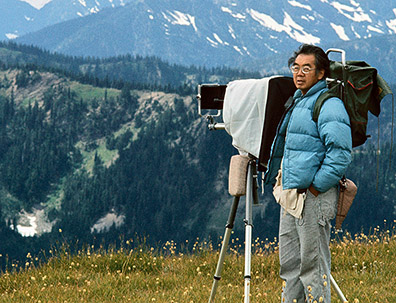Since 1965, I have developed a different way of seeing things. I am not interested in photographing the things that delimit one’s inner vision. For example, I avoid including the sky because it reveals the identity of the place. The horizon and ridge lines will give you ready answers. I like to give my viewers questions, not answers. Let them find beauty in the most mundane things, like roadside wildflowers and tumbled weeds. Observe the essence of things. That’s Zen. It doesn’t have to be some spectacular manifestation of nature.
My attitude of photographing is very, very serious. The act of selecting a subject to photograph is time-consuming. After the final selection of the subject, determination of exposure needs equally critical attention. I cannot approach the whole process haphazardly. The act of creative execution is not unlike performing music on the stage. You cannot sing three times and tell the audience to select the performance they like best. My negatives are my definitive statement and they need not be cropped or altered. At least that is what I aspire to.
I spend a lot of time looking for subjects. Oftentimes, I make a scouting trip, hiking for instance, going up a trail to a certain point. I usually leave my camera equipment behind, and hike and scout and come back, and if it’s worthwhile, I then take my camera up, and spend a long time adjusting, setting up, digesting or looking at it, and from different angles, distances, and so forth. And finally, when I find something, there always has to be a unifying, kinetic force. Which means the rhythm, and in musical terms the melodic lines. And polyphonic melodic lines especially, like Bach, for instance, or Handel and Mozart. Linear structures. And then its juxtaposition, its counterbalancing, which is called counterpoint in musical terms. And I find almost every time, when I see something, I always see melodic lines, and counterbalancing forces, and weight, and harmony. And that becomes the skeletal form of my photographs. So my photographs could always be interpreted through musical forms.
[/one_half] [one_half]
My idea has always been that photography should be considered as one of the major arts, not just paintings or sculpture as major art, but photography also. In order to compete for attention with oil paintings and watercolors, I thought photographs have to be about equal size. So that led me to using the large-format camera.
If my 2007 exhibition in Seoul was the climax of my photography career, this book I think of as the denouement. It is a definitive collection of what my publisher and I agree is my best work. And the production has involved my wife Monica, daughters Irene and Poki, their husbands John and George, granddaughter Sara and her husband David. It is hard to imagine a more wonderful way to spend my ninety-third year than continuing my life’s work surrounded by dear friends and family.
— Johsel Namkung, 2012
[/one_half]